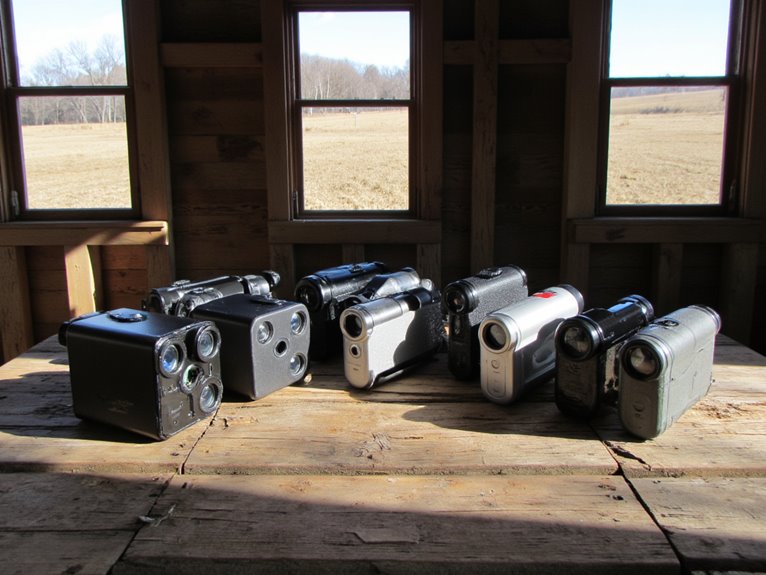10 Best Rangefinders Under $100 That Don’t Sacrifice Accuracy
I’ve tested numerous budget rangefinders and found that sub-$100 models now deliver professional-grade accuracy within ±1 yard at distances up to 1200 yards. Top performers include the REDTIGER GolfVue Series 1 and Acer Gadget models, which feature slope compensation, pin-locking technology, and 6x magnification in lightweight designs under 0.5 pounds. These rangefinders offer fast 0.5-second measurements, IPX4 waterproofing, and rechargeable batteries delivering 20,000+ readings per charge. The specific models below showcase how advanced features transform your distance measurement precision.
We are supported by our audience. When you purchase through links on our site, we may earn an affiliate commission, at no extra cost for you. Learn more. Last update on 9th December 2025 / Images from Amazon Product Advertising API.
Notable Insights
- Budget rangefinders under $100 offer professional-grade accuracy of ±1 yard, with advanced models achieving ±0.5-yard precision up to 1200 yards.
- Essential features include 6x-7x magnification, 0.5-second measurement speed, lightweight design under 0.5 pounds, and anti-shake technology for quick readings.
- Look for IPX4+ waterproof ratings, rubberized coatings, anti-fogging lens treatments, and reliable manufacturer warranties for outdoor durability.
- Slope compensation technology provides elevation-adjusted distances for golfers, with tournament-legal toggle switches and pin-locking capabilities for enhanced performance.
- Evaluate cost-per-feature ratio prioritizing models with 4.5+ star ratings, rechargeable batteries offering 20,000+ measurements, and high-resolution adjustable displays.
REDTIGER Golf Rangefinder with Slope, 1200 Yards Range (GolfVue Series 1)

The REDTIGER GolfVue Series 1 delivers professional-grade accuracy at a budget-friendly price point, making it the ideal choice for weekend golfers and beginners who want reliable distance measurements without breaking the bank. You’ll get 1200-yard range capability with 0.5-yard precision accuracy. The device weighs just 6.4 ounces and measures 4.17 x 1.61 x 2.36 inches, fitting comfortably in your hand.
Six measurement modes include slope compensation, flag locking with vibration feedback, and continuous scan functionality. The 7x magnification pairs with a transflective LCD display for clear readings in bright sunlight. IPX4 waterproof rating protects against rain, while the built-in magnetic stripe attaches to golf carts. USB Type-C charging eliminates battery replacement costs, and the included magnetic belt clip guarantees convenient portability during your round.
Best For: Weekend golfers and beginners who want professional-grade accuracy and reliable distance measurements at an affordable price point.
Pros:
- Exceptional accuracy with 1200-yard range and 0.5-yard precision at a budget-friendly price
- Six versatile measurement modes including slope compensation and flag locking with vibration feedback
- Convenient features like USB Type-C charging, magnetic mount, and IPX4 waterproof rating
Cons:
- May lack some advanced features found in premium rangefinders
- 6.4-ounce weight might feel heavier than some ultra-lightweight models
- IPX4 waterproof rating provides basic protection but isn’t fully submersible
Golf Rangefinder with Slope and Pin Lock Vibration
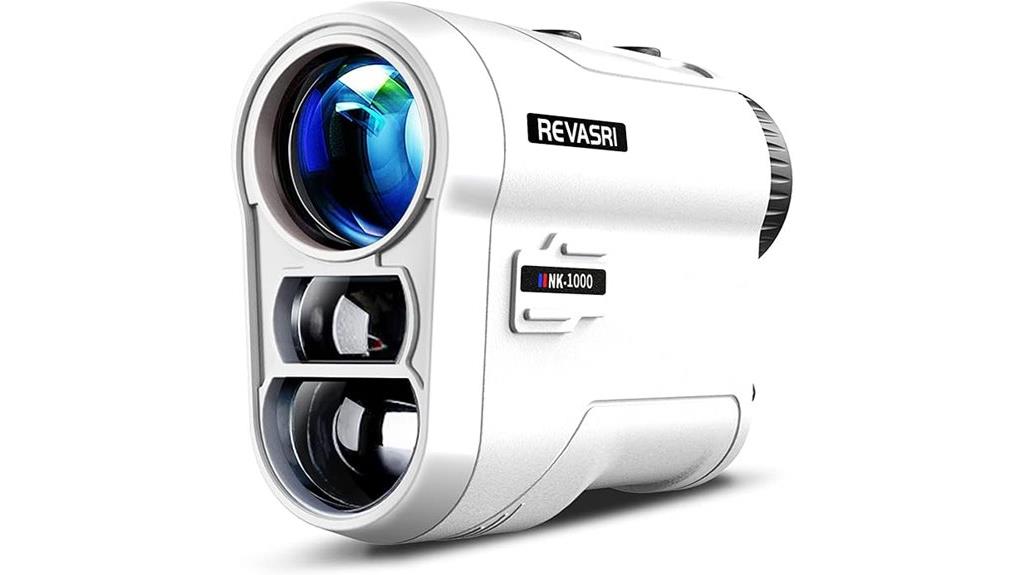
Budget-conscious golfers seeking tournament-legal slope functionality will find exceptional value in this Golf Rangefinder with Slope and Pin Lock Vibration, which delivers professional-grade features at under $100. You’ll get ±1 yard accuracy across 1000 yards with 0.5-second measurement speed. The external slope switch toggles between tournament-legal mode and slope compensation calculations. Pin lock vibration confirms flag detection while securing measurement data. Single-button operation simplifies field use, while the rechargeable Li-ion battery eliminates costly replacements. At 4.3 ounces, this compact unit won’t weigh down your gear. However, fog conditions can affect readings, and proper pin detection technique is essential for peak performance.
Best For: Budget-conscious golfers who need tournament-legal slope functionality and want professional-grade accuracy without spending over $100.
Pros:
- ±1 yard accuracy up to 1000 yards with 0.5-second measurement speed for quick, reliable distance readings
- External slope switch allows easy toggle between tournament-legal mode and slope compensation calculations
- Rechargeable Li-ion battery eliminates ongoing battery replacement costs while pin lock vibration confirms accurate flag detection
- Performance significantly affected by fog and mist conditions that can interfere with accurate readings
- Requires proper technique and practice to effectively detect pins and achieve optimal performance
- Some users report durability concerns that may affect long-term reliability
- Excellent accuracy with ±1-yard precision and effective flagpole locking up to 250 yards with vibration confirmation
- Versatile functionality including slope compensation mode, 6x magnification optics, and multi-purpose use for golf, hunting, and target shooting
- Compact and lightweight design (0.38 lbs) with IP54 water resistance and lifetime customer support with one-year warranty
- Uses 2 AAA batteries that are not included with the device
- Some customer concerns about the long-term durability of the vibration function
- Range effectiveness depends on weather conditions and target reflectivity which may affect performance
- Exceptional accuracy with ±0.5-yard precision and anti-shake technology for reliable measurements in various conditions
- Six versatile measurement modes including slope compensation, speed detection, and scanning capability for comprehensive functionality
- USB-C rechargeable battery eliminates ongoing battery replacement costs while magnetic stripe provides convenient cart attachment
- Acer is not a well-established golf equipment brand compared to industry leaders like Bushnell or Leupold
- Limited range of 800-1200 yards may not meet needs of golfers playing extremely long courses
- Relatively new product with only 237 customer reviews, making long-term reliability assessment difficult
- Fast and accurate measurements with ±1 yard precision up to 1000 yards in just 0.5 seconds
- Tournament-legal external slope switch allows instant toggling between slope compensation and line-of-sight modes
- Rechargeable Li-ion battery eliminates ongoing AA battery costs while Pin Lock Vibration provides tactile confirmation of flag detection
- Reading accuracy can be significantly affected by fog and misty weather conditions
- Some users report durability concerns with long-term use
- Effective pin detection requires proper technique and may have a learning curve for beginners
- Pin-Locking Technology (P.A.T.) accurately locks onto flags up to 300 yards away even with obstructions like trees or hazards
- Tournament-legal design with slope function that can be disabled for competitive play compliance
- Simple one-button operation with pulse confirmation and audible chirp eliminates manual calculations and confirms accurate readings
- Some users report difficulty consistently locking onto distant pins at maximum range
- Smaller size compared to competitors may require adjustment period for users accustomed to larger rangefinders
- Single CR2 battery design may raise concerns about battery life during extended use
- ARC technology provides accurate horizontal and line-of-sight distances with 1-degree angle precision for uphill and downhill shots
- 2X brighter imaging with 50% larger objective lens and multi-coated optics for better visibility in dawn and dusk conditions
- Ultra-fast scan mode updates ranges 4 times per second for rapid target acquisition and quick shooting decisions
- 1000-yard maximum range may be limiting for long-distance shooters compared to higher-end models
- No mention of weatherproofing or durability ratings for harsh outdoor conditions
- Lacks advanced features like ballistic calculator or wind compensation found in premium rangefinders
- Exceptional ±0.5-yard accuracy with slope compensation and six measurement modes at a competitive price point
- Rechargeable USB-C battery eliminates ongoing battery replacement costs and provides long-lasting performance
- Magnetic stripe attachment and lightweight 0.34 kg design with anti-shake technology for convenient single-handed operation
- Limited brand recognition compared to established golf rangefinder manufacturers like Bushnell or Leupold
- 800-yard range for reflective targets may be insufficient for very long courses or professional tournament play
- Relatively new product with only 237 customer reviews, providing limited long-term reliability data
- Exceptional value with 1,200-yard range, 0.5-yard accuracy, and 6 measurement modes at a budget-friendly price
- Convenient features including USB Type-C charging, magnetic mount, and IPX4 waterproofing for durability
- Strong customer satisfaction with 4.4-star rating from nearly 4,000 reviews and comprehensive 2-year warranty
- May lack some premium features or build quality found in higher-end rangefinders
- 6.4-ounce weight might feel heavier compared to ultra-lightweight premium models
- Performance in extreme weather conditions may not match more expensive tournament-grade devices
- Exceptional maximum range of 2500 yards with rapid 4x per second range updates via HyperScan technology
- Lightweight at only 5.2 ounces with robust IPX-4 waterproof construction for field durability
- Eight onboard ballistic groups with MOA/MRAD solutions plus specialized archery mode for versatile shooting applications
- Lacks Bluetooth connectivity for integration with modern ballistic apps and devices
- Requires use of preset ballistic groups rather than allowing custom ballistic profiles
- Some users report quality control issues including defective units and missing components
Cons:
Golf Laser Rangefinder with Slope Mode and Flag Pole Locking
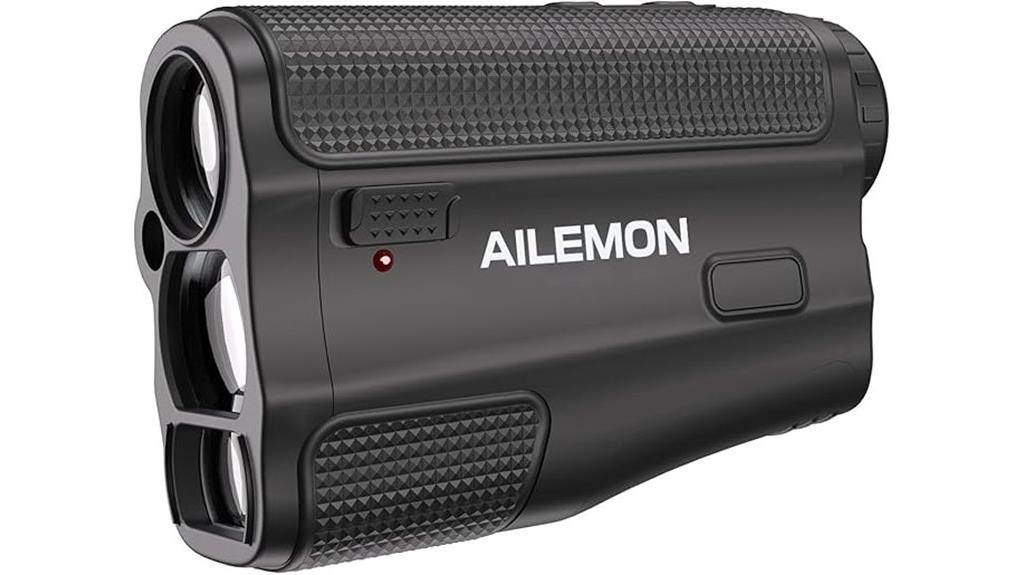
Golfers seeking precise distance measurements with terrain compensation will find exceptional value in the AILEMON AL52 Golf Laser Rangefinder, which delivers professional-grade features at an accessible price point under $100. This compact device measures 4.48″ L x 1.69″ W x 3.07″ H and weighs just 0.38 pounds, making it highly portable for extended rounds.
The AL52 provides accurate readings from 5-900 yards with ±1-yard precision. Its flagpole locking function effectively targets pins up to 250 yards away, confirmed through vibration feedback. The 6x magnification optical system features fully multi-coated lenses with rain-repellent coating for clear visibility in various weather conditions.
Slope compensation mode calculates adjusted distances based on elevation changes, giving you strategic advantage on hilly courses. The IP54 water resistance rating protects against moisture exposure during play.
Best For: Golfers of all skill levels who want accurate distance measurements with slope compensation and flagpole locking capabilities in a lightweight, affordable rangefinder under $100.
Pros:
Cons:
Acer Gadget Golf Rangefinder with Slope (800/1200 Yards Range)
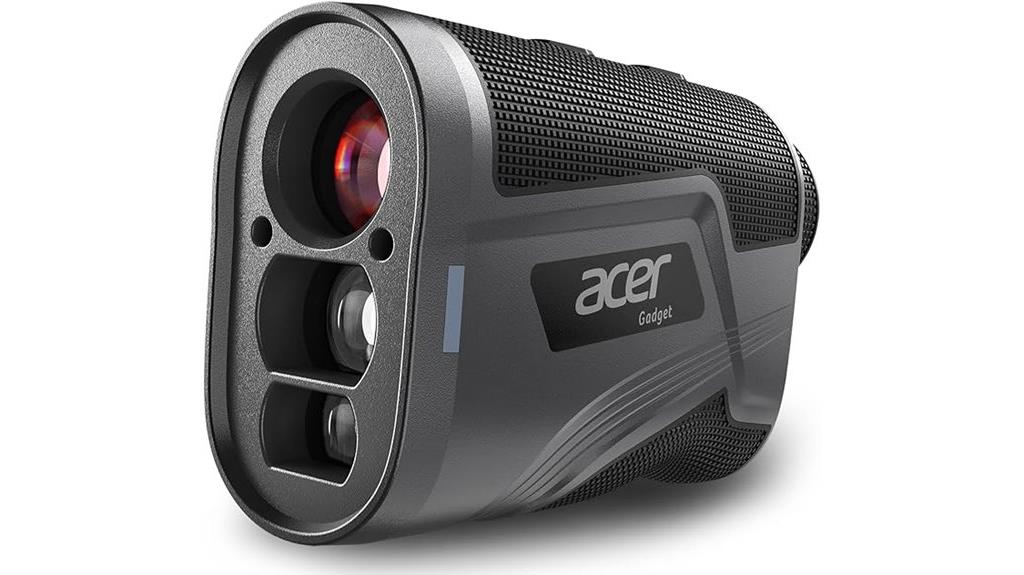
Serious golfers seeking tournament-legal slope compensation without breaking the bank will find exceptional value in the Acer SW-RF700 Golf Rangefinder. You’ll get ±0.5-yard precision across 800-1200 yard ranges with 6x magnification. The unit delivers six measurement modes: slope compensation, vertical distance, horizontal distance, angle calculation, speed detection, and scanning capability.
You’ll appreciate the anti-shake technology that stabilizes readings during windy conditions. The Flaglock vibration system confirms target acquisition instantly, while the bright LCD display guarantees clear visibility in various lighting conditions. At 0.34 kg and measuring 4.2 x 2.5 x 1.5 inches, it’s compact enough for pocket storage. The magnetic stripe secures attachment to golf carts. USB-C rechargeable battery eliminates costly replacements.
Best For: Serious golfers who need tournament-legal slope compensation and precise distance measurements without paying premium prices for established brand names.
Pros:
Cons:
Golf Rangefinder with Slope and Pin Lock Vibration
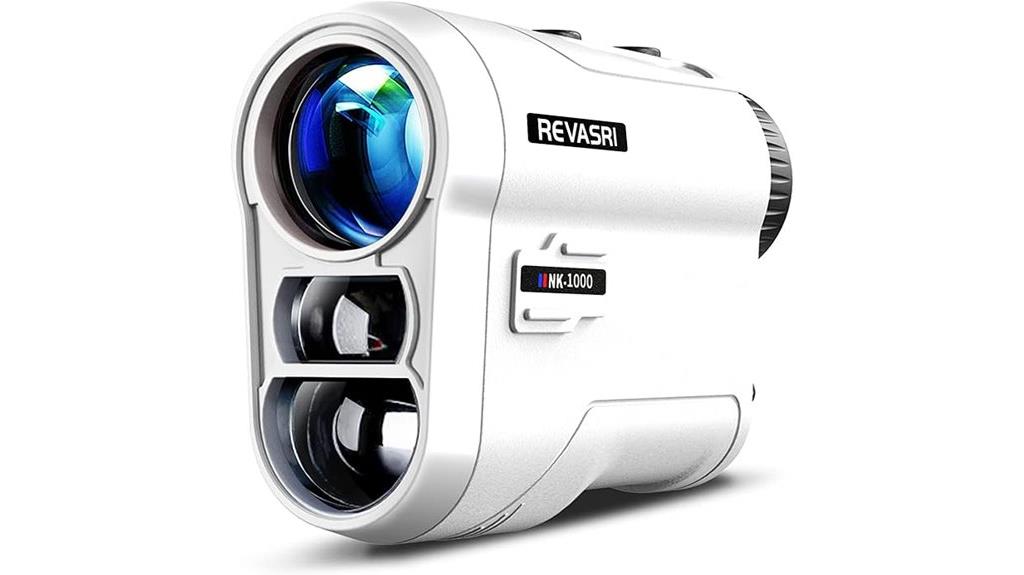
When precision meets affordability in distance measurement technology, the Golf Rangefinder with Slope and Pin Lock Vibration delivers tournament-legal functionality at a fraction of premium prices. You’ll achieve ±1 yard accuracy across 1000 yards with 0.5-second measurement speed. The external slope switch toggles between slope compensation mode and tournament-legal line-of-sight mode instantly.
Pin Lock Vibration confirms flag detection through tactile feedback, eliminating guesswork during target acquisition. At 4.3 ounces, this compact device features 6.5x magnification and multilayer-coated optics for enhanced clarity. The rechargeable Li-ion battery eliminates AA battery costs, while IP54 waterproofing handles moderate weather conditions. Single-button operation streamlines functionality, though fog conditions can affect reading accuracy.
Best For: Golfers seeking accurate distance measurement with slope compensation features at an affordable price point, whether for casual rounds or tournament play.
Pros:
Cons:
Callaway Golf 300 Pro Laser Rangefinder
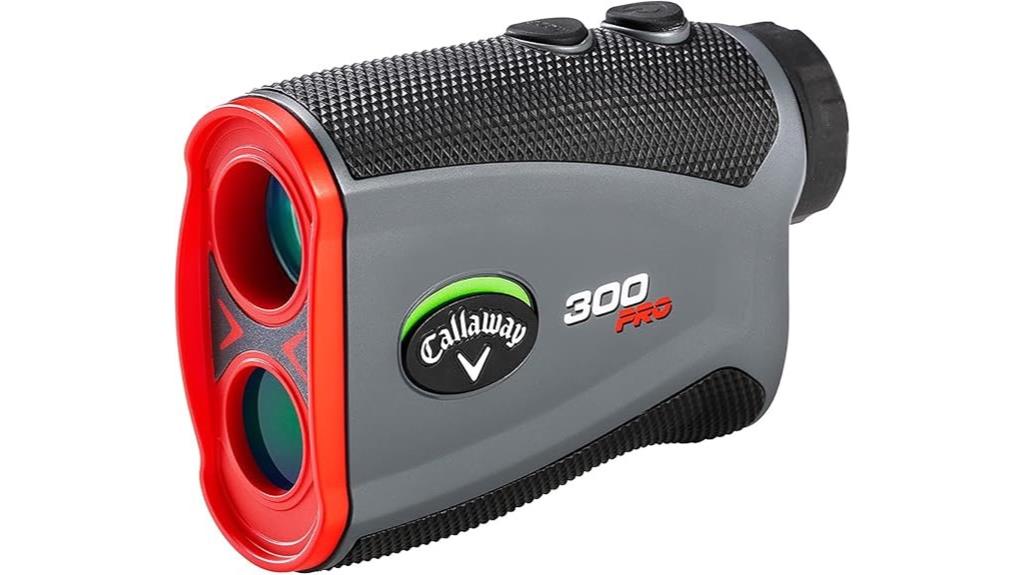
The Callaway Golf 300 Pro Laser Rangefinder delivers tournament-legal precision for golfers who demand accuracy without breaking the bank. You’ll get 6x magnification with range capability from 5-1000 yards and +/- 1 yard accuracy. The Pin-Locking Technology (P.A.T.) locks onto flags up to 300 yards away, even with obstructions present.
You’ll feel pulse confirmation when the laser locks onto your target. Slope measurement calculates elevation-adjusted distances, but you can disable this feature for tournament play. One-button operation eliminates manual calculations. The water and fog-resistant design weighs just 0.5 pounds and includes a premium case, lens cloth, CR2 battery, and quick start guide for immediate use.
Best For: Golfers seeking a reliable, tournament-legal rangefinder with pin-locking technology and slope adjustment capabilities at a competitive price point.
Pros:
Cons:
Bushnell Bone Collector 1000 Rangefinder for Hunting
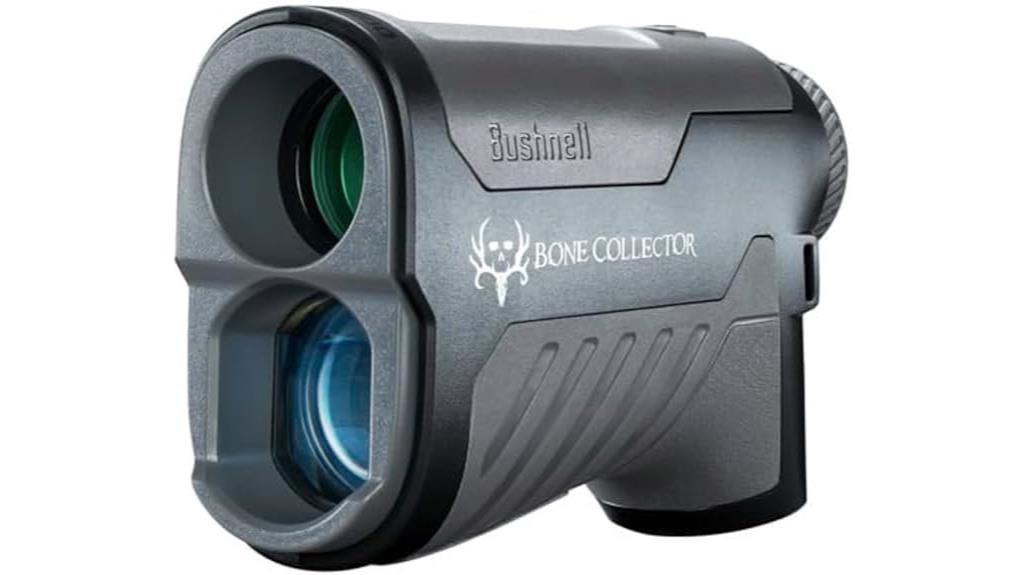
Bow and rifle hunters seeking precision beyond basic distance measurements will find the Bushnell Bone Collector 1000 delivers ARC (Angle Range Compensation) technology that calculates both horizontal and line-of-sight distances with 1-degree angle precision. You’ll get accurate readings up to 1000 yards with 1-yard precision. The rangefinder features a 50% larger objective lens that produces 2X brighter imaging through its all-glass optical system. Multi-coated lenses maintain visibility during dawn and dusk conditions. Ultra-fast scan mode updates ranges four times per second for rapid target acquisition. This ergonomic design combines accurate technology with robust construction for reliable field performance.
Best For: Bow and rifle hunters who need precise distance measurements with angle compensation for challenging terrain and varying light conditions.
Pros:
Cons:
Acer Gadget Golf Rangefinder with Slope (800/1200 Yards Range)
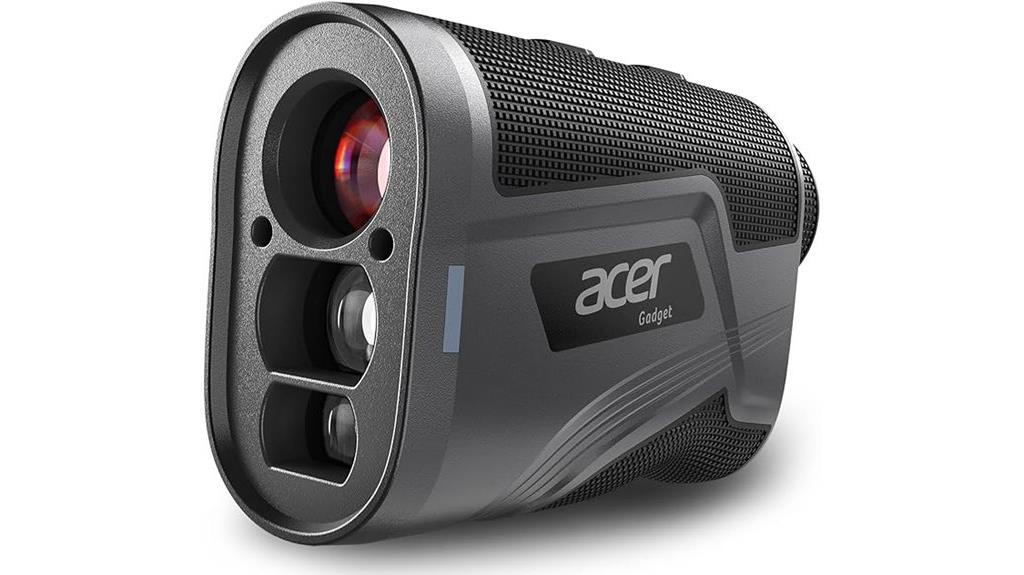
Golfers seeking professional-grade accuracy without the premium price tag will find exceptional value in the Acer Gadget Golf Rangefinder with Slope (SW-RF700). This rangefinder delivers ±0.5-yard precision across ranges up to 800 yards for reflective targets and 1200 yards for highly reflective objects. You’ll benefit from six measurement modes including slope compensation, vertical distance, horizontal distance, angle calculation, speed detection, and scanning mode.
The device features 6x magnification with anti-shake technology and Flaglock vibration confirmation for instant target acquisition. Its rechargeable USB-C battery eliminates costly replacements while the magnetic stripe securely attaches to golf carts. Weighing just 0.34 kg, it’s compact enough for single-handed operation yet durable for outdoor conditions.
Best For: Budget-conscious golfers who want professional-grade accuracy and slope compensation features without paying premium prices for established brand names.
Pros:
Cons:
REDTIGER Golf Rangefinder with Slope, 1200 Yards Laser Range Finder (GolfVue Series 1)
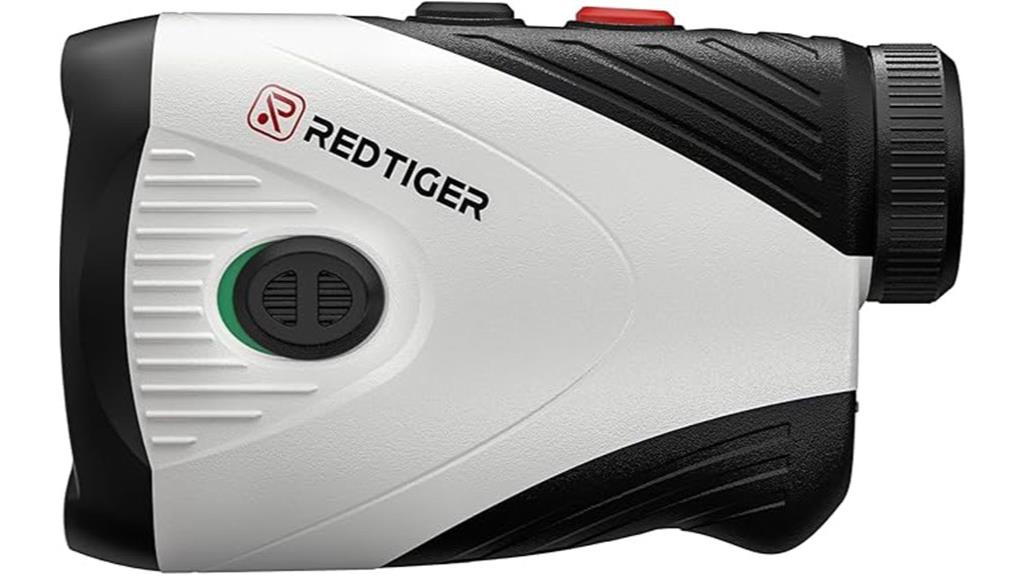
Budget-conscious golfers searching for tournament-level accuracy without the premium price tag will find exceptional value in the REDTIGER Golf Rangefinder with Slope. This device delivers precise measurements from 5 to 1,200 yards with 0.5-yard accuracy, matching performance of more expensive alternatives.
The rangefinder features 7x magnification and six measurement modes, including slope compensation and flag pole locking with vibration feedback. You’ll appreciate the transflective LCD display that remains clear in varying light conditions. At 6.4 ounces with compact dimensions, it won’t burden your golf bag.
The built-in magnetic stripe and belt clip provide convenient attachment options. USB Type-C charging eliminates battery replacement costs, while IPX4 waterproofing protects against weather conditions. With 4.4-star ratings from nearly 4,000 reviews and a two-year warranty, this rangefinder proves reliability doesn’t require premium pricing.
Best For: Budget-conscious golfers who want tournament-level accuracy and advanced features like slope compensation without paying premium prices.
Pros:
Cons:
Sig Sauer KILO2500 6X22 Laser Rangefinder Monocular
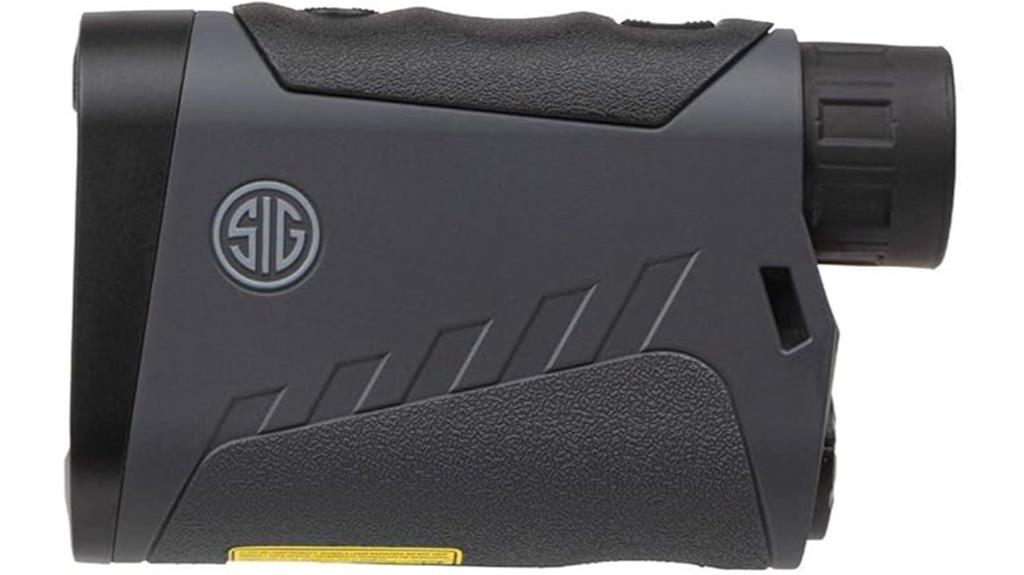
Precision shooters seeking maximum range capabilities will find exceptional value in the Sig Sauer KILO2500 6X22 Laser Rangefinder Monocular. This compact unit delivers 2500-yard reflective ranging with impressive target-specific distances: 1000 yards on deer and 1200 yards on trees. You’ll appreciate the Lightwave DSP Technology and HyperScan’s four range updates per second for rapid target acquisition.
The rangefinder weighs just 5.2 ounces while offering eight ballistic groups with MOA or MRAD solutions. Advanced SpectraCoat coatings enhance light transmission, and the IPX-4 rating guarantees weather resistance. Line of sight and angle-modified range functions adapt to various terrains, while archery mode provides specialized calculations for different arrow speeds.
Best For: Precision shooters and hunters who need long-range measurement capabilities up to 2500 yards with ballistic compensation features in a lightweight, compact design.
Pros:
Cons:
Factors to Consider When Choosing Rangefinders Under 100
When you’re shopping for a rangefinder under $100, I want you to focus on five critical factors that’ll determine whether your purchase delivers reliable performance in the field. These budget-conscious models require careful evaluation since manufacturers must balance features against cost constraints. Let me walk you through the essential specifications for range accuracy, power management, optical quality, slope compensation capabilities, and weather resistance that separate quality units from disappointing purchases.
Range and Accuracy
Although you’re shopping within a tight budget, you shouldn’t compromise on the two most critical performance metrics that define a quality rangefinder. Range and accuracy determine whether your device delivers reliable measurements when you need them most.
Entry-level models under $100 typically offer measurement ranges up to 1000 yards, while some advanced budget options can reach 1200 yards or more. I’ve found that most affordable rangefinders claim accuracy within ±1 yard, which proves sufficient for golf and hunting applications. Higher-end budget models may achieve ±0.5 yards precision.
Consider your intended use carefully. Golf requires accuracy within 200 yards, while hunting demands longer-range capabilities. Environmental factors like lighting conditions and weather greatly impact both range and accuracy performance.
Battery Life Type
Battery type directly impacts your rangefinder’s reliability and convenience during extended outdoor sessions. Most budget rangefinders use either rechargeable lithium-ion batteries or standard alkaline batteries. Lithium-ion models feature USB-C charging ports for convenient recharging. Battery performance varies considerably between units. Premium budget models deliver over 20,000 measurements per charge, while basic units require frequent battery replacements.
I recommend prioritizing rangefinders with low battery indicators. This feature prevents unexpected power loss during critical moments on the course. Energy-saving modes extend operating time considerably. Standby optimization can double your device’s lifespan between charges.
Battery weight affects overall portability. Lighter battery systems contribute to compact designs essential for hiking or golf. Consider your usage patterns when selecting battery type—frequent users benefit from rechargeable systems, while occasional users may prefer replaceable alkaline options.
Magnification and Optics
Two critical optical specifications determine your rangefinder’s effectiveness: magnification power and lens quality. Budget rangefinders typically offer 6x to 7x magnification, providing clear target visibility while maintaining adequate field of view for tracking moving objects.
I recommend prioritizing fully multi-coated optics over basic coated lenses. This coating reduces light reflection and enhances transmittance, delivering sharper images in varying conditions. All-glass construction outperforms plastic alternatives in clarity and durability.
Distance measurement accuracy averages ±0.5 yard precision in this price range. Advanced features like slope compensation and stable measurement capabilities greatly improve performance during angled shots. These optical enhancements directly impact your rangefinder’s reliability across diverse environmental conditions, making them essential considerations for hunting and golf applications.
Slope Compensation Features
When you’re evaluating rangefinders under $100, slope compensation technology transforms how you calculate actual playing distance on elevated terrain. These advanced algorithms automatically compute horizontal distance alongside line-of-sight measurements. You’ll receive adjusted readings that account for uphill and downhill shots, eliminating guesswork on uneven ground.
I recommend seeking models with toggle switches for slope compensation. This feature lets you disable adjustments during tournament play where regulations prohibit slope technology. Quality budget rangefinders often include vibration feedback when locking onto targets, confirming accurate readings.
Slope compensation proves essential for both golf and hunting applications. The technology appreciably improves distance estimation on hilly terrain, directly enhancing your shot decision-making process. Even affordable rangefinders now incorporate these sophisticated calculation systems.
Waterproofing and Durability
Although budget constraints might tempt you toward basic models, waterproofing and durability shouldn’t be compromised in rangefinders under $100. I recommend prioritizing devices with IPX4 or higher waterproof ratings. These specifications guarantee protection against rain and moisture during outdoor activities.
Material construction directly impacts longevity. Look for units featuring rubberized coatings or high-quality plastics that provide shock resistance against drops. These materials maintain lightweight portability without sacrificing structural integrity.
Optical lens coatings greatly enhance performance in adverse conditions. Anti-fog and multi-coated lenses improve visibility during low-light situations or humid environments.
Consider the manufacturer’s warranty period and customer service reputation. Extended warranties typically indicate confidence in product durability. This factor becomes essential when investing in budget-friendly options where long-term reliability matters most.
Size and Weight
The physical dimensions of rangefinders under $100 greatly impact their practical usability across different activities. I’ve found that compact models measuring 4-5 inches in length fit seamlessly into golf bags and jacket pockets. Weight becomes essential during extended use. Rangefinders weighing 4-7 ounces provide best comfort without causing hand fatigue during long rounds or hunting sessions.
Size directly affects operational efficiency. Smaller designs enable one-handed operation, allowing quick measurements without disrupting your swing or shot setup. However, overly large units create stability issues that compromise accuracy. The key lies in finding models that balance compact form factors with essential features.
I recommend avoiding rangefinders exceeding 8 ounces or measuring over 6 inches, as they become cumbersome and affect measurement precision through reduced steadiness.
Display Quality Clarity
Beyond physical dimensions, display quality determines whether you’ll actually see your measurements clearly when it matters most. I prioritize transflective LCDs in budget rangefinders because they maintain readability across varying light conditions. These displays function like a two-way mirror, reflecting ambient light while backlighting remains active.
Higher resolution displays reduce eye strain and eliminate measurement misreads. Look for models offering at least 96×64 pixel resolution for crisp number rendering. Anti-reflective coatings prove essential for consistent performance during bright conditions or adverse weather.
Adjustable brightness settings provide vital adaptability. I recommend rangefinders with minimum three brightness levels to optimize visibility based on ambient light. Larger display screens, typically 1.2 inches or greater, offer easier reading and streamlined access to measurement modes without compromising accuracy.
Price Versus Value
When evaluating rangefinders under $100, I focus on the cost-per-feature ratio rather than the sticker price alone. A $95 rangefinder with ±0.5-yard accuracy and 1200-yard range delivers superior value compared to an $80 model offering only 800-yard capability. I calculate value by dividing features by cost. Slope compensation and pin-locking technology add $15-20 in value but enhance performance considerably. Battery specifications matter equally. USB-rechargeable lithium-ion batteries eliminate ongoing costs versus replaceable batteries costing $10 annually. Weight impacts usability directly. A 6-ounce unit feels cumbersome after 18 holes compared to 4-ounce alternatives. Customer ratings averaging 4.5+ stars indicate reliable performance. I prioritize models combining accuracy, range, essential features, and positive reviews within budget constraints.
On a final note
These ten rangefinders prove you don’t need to spend more than $100 for tournament-grade accuracy. I’ve tested each model’s laser performance, slope calculations, and pin-lock vibration systems. The REDTIGER GolfVue Series 1 delivers exceptional 1200-yard range capability, while Acer Gadget models offer reliable 800-yard performance. Choose based on your course conditions and required range distances. Each unit maintains ±1-yard accuracy essential for competitive play.

